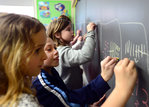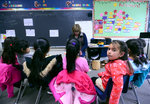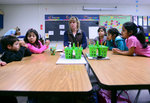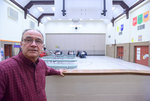




The classroom setting where kids raise their hands and wait for the teacher to call on them is becoming a thing of the past at Edison Elementary School in Centralia.
The school has implemented a model called Kagan Cooperative Learning, in which youths sit in groups and work in a team environment. When a teacher asks a question, each student tells his or her answer to a partner. This way each student is held accountable for the entire lesson, instead of one student being called on at a time.
“They’re all highly engaged,” said principal Neal Kirby. “The kids learn to relate to one another.”
After Edison implemented the model, Kirby said, referrals for discipline dropped by 70 percent.
In addition to improving behavior and increasing accountability, the method helps students build trust, which Kirby said could be the key to his school’s success.
Edison received an “A Exemplary” ranking earlier this month on the Washington Policy Center’s public school achievement index, which assigns letter grades for more than 2,000 educational institutions across the state.
The independent think tank bases the grades on the State Board of Education’s Achievement Index, which is a snapshot of a school’s performance based on statewide assessments, student achievement, graduation rates and yearly improvement compared to other schools with similar demographics.
Of the 45 Lewis County area academic institutions included in the policy center’s index, Edison was the only elementary school to earn an “A,” except the Pe Ell School, which includes kindergarten through 12th grade. But, unlike Pe Ell, Edison has continually received “Exemplary” or “Very Good” marks since 2007.
“Edison’s consistent success is significant,” Liv Finne, the Washington Policy Center’s director, said in an email to The Chronicle. “Sadly, it is all too rare.”
Finne said the key to replicating Edison’s success in other schools is accountability from the top down.
And, Kirby said, it’s accountability and trust that have worked well at Edison.
Teachers participate in Professional Learning Communities, or groups designed for educational opportunities and accountability, within their grade levels and schoolwide.
“Commitments to your colleagues are far more powerful than commitments to the principal,” Kirby said. “And they can take risks.”
The PLCs meet regularly to review assessments, share scores and determine which individual students have met the standards.
That’s when the school’s different approach to Response to Intervention, which identifies and reteaches struggling students, comes in.
One third of students at Edison participate in the afterschool program designed to give extra help to those who struggle academically. About 90 students receive 50 additional minutes of instruction after school 120 days a year. The time is spent focusing on math, reading, language learning and computer lab work.
“We really want to praise the Edison staff,” Superintendent Steve Bodnar said.
Since Edison’s afterschool program is succeeding, Bodnar has implemented it into the other elementary schools districtwide.
Educators look at data from statewide assessments and work to close the gaps, Kirby said. For example, last year, the staff identified a multi-year trend of girls significantly outscoring boys in reading on standardized tests.
While boys typically prefer expository stories with factual information, Kirby said, girls generally like narratives. When the staff investigated the girls’ higher scores, they found that 70 percent of the reading material the school was using was narrative. Now, Edison uses half expository and half narrative reading materials in an effort to even students’ scores.
English instruction is also a focus of the staff. Edison has a 34 percent Hispanic population, with almost 22 percent learning English as a second language.
“That’s the largest percentage in the district,” Kirby said. “Edison has a reputation for being a higher income school but really our poverty rate is quite high.”
Edison has a 78 percent poverty rate.
Kirby said the school recently had a meeting where 14 Spanish-speaking parents who do not speak English attended. One of the staff members translated to communicate that those parents can still help educate their children.
“They can read in any language they want and still be working on skills,” Kirby said, noting that literary concepts like setting, plot and characters apply in any language.
Since the meeting, Kirby said, there has been an increase in the number of bilingual books checked out from Edison’s library.
Kirby said good parent involvement has contributed to the school’s success.
Even educational assistants are treated differently at Edison. Kirby said he has worked hard to keep the same paraeducators at the same grade levels, which builds trust between teachers and staff.
“They start learning the curriculum as well as the teachers,” he said.
Kirby said one can feel the high level of trust in his building and he often hears visitors comment on the atmosphere.
“There’s really a high level of trust that can be correlated with success,” Kirby said. “When you have that high level of trust, you can learn from each other.”
Finne said her staff at the Washington Policy Center publishes the achievement index so schools could learn from each other.
“The policy center believes giving letter grades to schools is such a necessary reform — it will put outside pressure on school leaders to improve results for children,” she said. “Whatever Edison is doing is working. And it has been working for some time. This is significant.”
•••
Amy Nile: (360) 807-8235
twitter.com/AmyNileReports
www.facebook.com/AmyNileTheChronicle